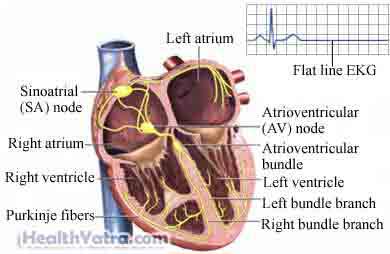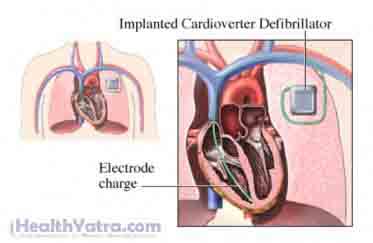সংজ্ঞা
Tachycardia is a rapid heart rate of more than 100 beats per minute. Sinus tachycardia, from the heart’s sinus node, is a normal response to exercise, illness, or stress.
There are several types of abnormal tachycardias or arrhythmias. These can come from two places:
- Atria (the two smaller chambers on the top of the heart)—called supraventricular tachycardias
- Ventricles (the lower chambers of the heart)—called ventricular tachycardia
This condition can be life-threatening. But, it can be treated. If you think you or someone you know has this condition, get emergency help.

কারণসমূহ
This condition is caused by abnormal electrical impulses that control the heart.
ঝুঁকির কারণ
These factors increase your chance of having tachycardia. Tell your doctor if you have any of the following:
- Heart disease, especially a prior heart attack
- Cardiomyopathy —damage to the muscle wall of the lower chambers of the heart
- Electrolyte abnormalities—too much or too little calcium, sodium, magnesium, and potassium in the blood
- Myocardial ischemia—insufficient blood flow to heart muscle tissue
- Hypoxemia—not enough oxygen in the blood
- Acidosis—too much acid in the body’s fluids
লক্ষণ
If you have any of these symptoms do not assume it is due to this condition. These উপসর্গ সৃষ্টি হতে পারে অন্যান্য শর্ত দ্বারা। আপনার যদি এইগুলির মধ্যে কোনটি থাকে তবে আপনার ডাক্তারকে বলুন:
- হৃদস্পন্দন
- দ্রুত হার্ট রেট
- মাথা ঘোরা
- হালকা মাথাব্যথা
- Fainting or near fainting
- বুক ব্যাথা
- নিঃশ্বাসের দুর্বলতা
রোগ নির্ণয়
- Your doctor will ask about your symptoms and medical history. You will also have an exam. Tests may include the following:
- Electrocardiogram (ECG, EKG) —a test that records the heart’s activity by measuring electrical currents through the heart muscle
- Holter monitor or event monitor —an ambulatory monitor to record your heart rhythm that can be worn from 1-30 days to detect arrhythmias and correlate symptoms with the heart rhythm
- Exercise test —particularly if the symptoms occur during physical activity
- Electrophysiology study —an invasive test where monitoring wires are placed inside the heart and the heart’s conduction system is tested directly
- Cardiac catheterization —a tube-like instrument inserted into the heart through a vein or artery (usually in the arm or leg) to detect problems with the heart and its blood supply
চিকিৎসা
আপনার জন্য সেরা চিকিত্সা পরিকল্পনা সম্পর্কে আপনার ডাক্তারের সাথে কথা বলুন। চিকিত্সার বিকল্পগুলির মধ্যে নিম্নলিখিতগুলি অন্তর্ভুক্ত রয়েছে:
ওষুধ
The following medications are used to treat this condition:
- Beta-blockers (eg, atenolol, metoprolol, bisoprolol)
- Calcium channel blockers (eg, diltiazem, verapamil)
- Anti-arrhythmics, such as flecainide (Ambocor), procainamide (Procanbid), amiodarone (Cordarone), and sotalol (Betapace)
বিমোচন
Ablation is done during an electrophysiology study. Radiofrequency energy or cold energy is used to destroy the abnormality and possibly cure the problem.
Cardioverison
An electric shock is applied to the heart to stop the abnormal rhythm. This treatment may be done for life-threatening rhythms, such as ventricular tachycardia orventricular fibrillation. It is also done for milder arrhythmias, such as atrial fibrillation.
Implantable Cardioverter Defibrillator (ICD)
An ICD can be surgically placed into your body. This device monitors your heartbeat. It can apply a shock to correct an irregular heartbeat.

প্রতিরোধ
Reducing risk of heart disease is the best way you can prevent this condition. Take the following steps:
- Maintain a healthy weight
- Begin a safe exercise program with the advice of your doctor
- If you smoke, quit
- Eat a healthful diet, one that is low in saturated fat and rich in whole grains, fruits, and vegetables
- Manage stress
- Avoid or limit the intake of caffeine and alcohol
- Have regular physical exams
- Treat underlying medical problems (eg, high blood pressure, cholesterol problems)
